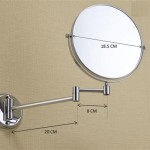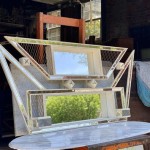How To Hang 3 Small Round Mirrors
Incorporating mirrors into interior design can significantly enhance a space, creating the illusion of greater size, amplifying natural light, and adding visual interest. Using a collection of small, round mirrors is a particularly effective strategy for achieving these effects. This article provides a detailed guide on how to hang three small round mirrors, covering preparation, layout options, and the actual hanging process, ensuring a professional and aesthetically pleasing result.
Before initiating the project, careful planning and preparation are essential. This involves gathering the necessary tools and materials, selecting a suitable location, and determining the desired arrangement for the mirrors. Poor planning can lead to uneven spacing, insecure mounting, and ultimately, an unsatisfactory outcome.
1. Gathering Tools and Materials
The first step in preparing to hang the mirrors is to assemble all the required tools and materials. This ensures a smooth and efficient process, minimizing potential delays and frustration. The following items constitute a comprehensive list:
Mirrors: Naturally, the three small round mirrors are the core component. Inspect each mirror for any defects, such as scratches or cracks, before proceeding. Verify that the mirrors are equipped with appropriate mounting hardware, such as D-rings or sawtooth hangers, on the back.
Measuring Tape: A measuring tape is indispensable for accurately determining the spacing between the mirrors and their distance from surrounding objects. Precision in measurement is crucial for achieving a balanced and harmonious arrangement.
Level: A level, either a traditional bubble level or a laser level, is necessary to ensure that the mirrors are hung straight. This prevents a tilted or uneven appearance, which can detract from the overall aesthetic.
Pencil: A pencil is used for marking the desired locations for the mounting hardware on the wall. Use a soft lead pencil to avoid damaging the wall surface. Erasing stray marks is also easier with a pencil.
Drill (with appropriate drill bits): A drill is required for creating pilot holes in the wall, especially when hanging mirrors on hard surfaces like plaster or drywall with studs. Ensure that the drill bit is appropriately sized for the wall anchors or screws being used.
Screwdriver (appropriate for screws): A screwdriver, either manual or powered, is needed to drive the screws into the wall anchors or directly into the wall studs. Use the correct type of screwdriver head (Phillips or flathead) to avoid stripping the screw heads.
Wall Anchors (if necessary): Wall anchors provide secure mounting for mirrors, especially when a wall stud is not available at the desired location. Choose wall anchors that are appropriate for the weight of the mirrors and the type of wall material (drywall, plaster, etc.). Consider using self-drilling anchors for ease of installation.
Screws or Nails: Screws are generally preferred over nails for hanging mirrors, as they provide a more secure and durable hold. Select screws or nails that are compatible with the wall anchors and the mounting hardware on the back of the mirrors. Choosing screws with a broad head will prevent them from pulling through the mounting hardware.
Painter's Tape (optional): Painter's tape can be used to temporarily position the mirrors on the wall to visualize the arrangement before committing to permanent placement. This helps to refine the layout and ensure that the mirrors are located precisely where desired.
Safety Glasses: Safety glasses are essential to protect the eyes from debris when drilling into the wall. This is a simple precaution that can prevent serious eye injuries.
Dust Mask (optional): A dust mask can be helpful to prevent inhalation of dust and particles generated during drilling. This is particularly important when working with materials like plaster or old drywall.
2. Determining Layout and Spacing
The arrangement of the mirrors is a crucial element in achieving the desired aesthetic effect. Several layout options are possible, each offering a unique visual impact. Consider the size of the wall space, the surrounding decor, and the desired mood when selecting a layout.
Horizontal Row: Arranging the mirrors in a horizontal row is a classic and versatile option. This layout works well above furniture, such as a sofa, console table, or headboard. Ensure that the mirrors are equally spaced and that the row is centered above the furniture. The horizontal arrangement emphasizes width, making it suitable for visually widening a narrow space.
Vertical Column: Placing the mirrors in a vertical column is another effective arrangement, particularly in narrow hallways or small bathrooms. This layout draws the eye upwards, creating the illusion of greater height. Maintain consistent spacing between the mirrors and ensure that the column is aligned vertically with a central point or architectural feature.
Triangular Arrangement: A triangular arrangement, with one mirror at the apex and the other two forming the base, offers a more dynamic and contemporary look. This layout can be particularly effective in creating a focal point on a blank wall. Experiment with different triangle orientations to find the most visually appealing arrangement for the specific space. Consider an equilateral triangle for a balanced look or an isosceles triangle for a more dramatic effect.
Staggered Arrangement: A staggered arrangement, where the mirrors are placed at slightly different heights and positions, creates a more casual and eclectic feel. This layout is well-suited for adding visual interest to a gallery wall or a less formal space. Ensure that the staggering is intentional and balanced, avoiding a haphazard or cluttered appearance. Use painter's tape to experiment with different positions before committing to the final arrangement.
Spacing Considerations: Once the layout is determined, the spacing between the mirrors is a critical factor. Consistent spacing creates a sense of order and visual harmony. As a general guideline, maintain a spacing of between 2 to 4 inches between the mirrors, depending on their size and the overall scale of the arrangement. Use the measuring tape to accurately measure and mark the desired spacing on the wall.
Eye Level: When determining the placement of the mirrors, consider the average eye level of the individuals who will be viewing them. Ideally, the center of the arrangement should be at or slightly above eye level. This ensures that the mirrors are visually accessible and contribute to the overall aesthetic appeal of the space.
Using Templates: To further aid in visualizing the arrangement and ensuring accurate placement, consider creating paper templates that match the size of the mirrors. Tape these templates to the wall in the desired layout and spacing. This allows for easy adjustment and refinement before drilling any holes. The templates also serve as a guide for marking the locations of the mounting hardware.
3. Hanging the Mirrors Securely
With the tools and materials gathered and the layout determined, the final step is to hang the mirrors securely. This involves accurately marking the wall, drilling pilot holes, installing wall anchors (if necessary), and attaching the mirrors using screws or nails. Proper execution of these steps is essential to ensure that the mirrors are safely and securely mounted.
Marking the Wall: Using the pencil and measuring tape, accurately mark the locations for the mounting hardware on the wall. Refer to the paper templates (if used) or the measurements taken during the layout planning. Ensure that the marks are level and aligned according to the desired arrangement. Double-check the measurements before proceeding to the next step.
Drilling Pilot Holes: Using the drill and the appropriately sized drill bit, create pilot holes at the marked locations on the wall. If installing wall anchors, drill the pilot holes to the size specified by the anchor manufacturer. If drilling into a wall stud, a pilot hole is still recommended to prevent the wood from splitting. Safety glasses should be worn during this process to protect the eyes from debris.
Installing Wall Anchors: If wall studs are not available at the desired locations, wall anchors are necessary to provide secure mounting. Insert the wall anchors into the pilot holes, ensuring that they are flush with the wall surface. Different types of wall anchors require different installation methods, so follow the manufacturer's instructions carefully. Self-drilling anchors can be screwed directly into the drywall without pre-drilling a pilot hole.
Attaching the Mirrors: Align the mounting hardware on the back of the mirrors with the pilot holes or wall anchors. Insert the screws or nails into the mounting hardware and tighten them securely. Ensure that the screws or nails are long enough to penetrate the wall anchors or studs, but not so long that they protrude through the front of the wall. Avoid over-tightening the screws, as this can damage the wall or the mounting hardware.
Using Wire or Chain: If the mirrors are designed to be hung with wire or chain, ensure that the wire or chain is securely attached to the mounting hardware on the back of the mirrors. Adjust the length of the wire or chain to achieve the desired hanging height. Use appropriate hooks or hangers on the wall to support the weight of the mirrors. Ensure that the hooks or hangers are securely mounted to the wall studs or using wall anchors.
Checking Stability: Once the mirrors are hung, check their stability by gently pressing on them. Ensure that they are securely mounted and do not wobble or shift. If any instability is detected, tighten the screws or nails or consider using larger wall anchors. Periodically check the stability of the mirrors over time to ensure that they remain securely mounted.
Cleaning the Mirrors: After hanging the mirrors, clean the surfaces with a glass cleaner and a soft cloth to remove any fingerprints, dust, or smudges. This will enhance the appearance of the mirrors and ensure that they reflect light effectively.
By following these detailed steps, individuals can successfully hang three small round mirrors, enhancing the aesthetics and functionality of their living spaces. Careful planning, accurate execution, and attention to detail are the keys to achieving a professional and visually pleasing result.

10 Simple Ways To Decorate Around A Round Mirror Wikihow

How To Hang Circular Mirror Tradux Mirrors

Round Mirror Options Create Enjoy

Sunray Set Of 3 Gold Round Mirror Decorative Wall Art Circle Vintage Sunburst Decor For Living Room Bathroom Hallway Bedroom

Wonderful Creative Entryways With Mirrors Porthole Mirror Gold Wall Decor

How To Hang A Mirror Safavieh Home Furnishings

10 Simple Ways To Decorate Around A Round Mirror Wikihow

10 Simple Ways To Decorate Around A Round Mirror Wikihow

Small Round Mirrors For Wall Decor Set Of 3 Gold Brushed Decorations Li

20 Incredibly Clever Ways To Decorate With Mirrors In A Small Living Room Michael Helwig Interiors








